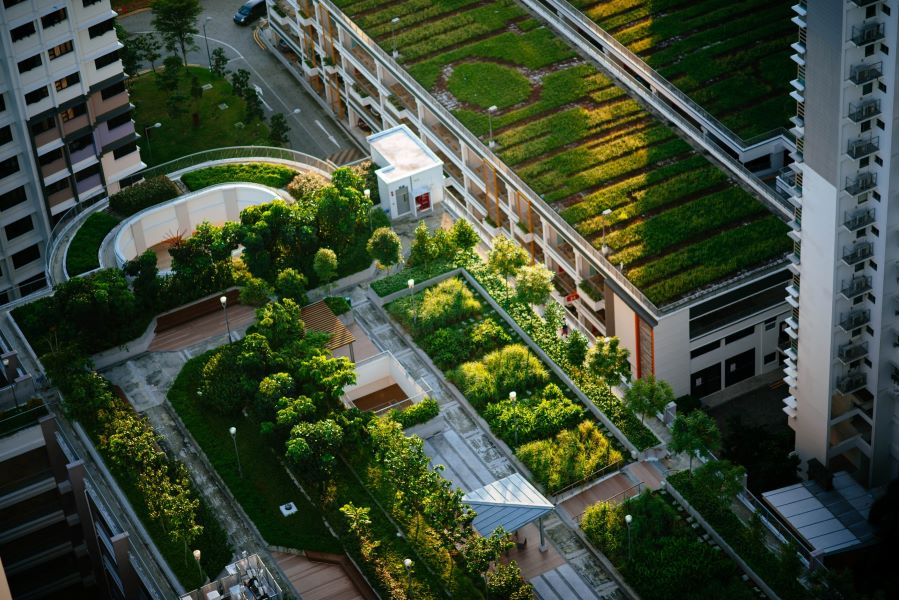Trends in Green Spaces for Commercial Clients
By Evelyn Long

A beautiful commercial landscape design can make an outdoor space more inviting for visitors and create a relaxing environment for employees and residents. Tall trees, colorful flowers and whimsical grasses can help clients achieve the outdoor living they’re after.
People are becoming more eco-sustainable, and upgrading commercial spaces with greenery also conveys a company’s commitment to greater environmental stewardship and responsibility.
There are so many landscaping options, and it’s essential to be aware of what’s most popular. Here are five trends in green spaces for commercial clients to consider – from low-maintenance shrubbery to community gardens that encourage team building.
1. Merged indoor-outdoor spaces
Blending indoor and outdoor commercial spaces is a trend that employees and customers desire in today’s modern landscaping. This is particularly evident for clients in the hospitality industry. According to the National Restaurant Association’s 2021 State of the Restaurant Industry report, 61% of fine dining and 56% of casual dining establishments have added an outdoor eating area since 2020.
Merging landscapes is relatively easy, whether incorporating natural elements indoors or creating a continuous flow with a walk-out restaurant patio. Large potted plants can welcome customers when they set foot into a business, while pops of color from tropical plants, vines and flowers will brighten up the room.
Enhance outdoor areas with distinctive features such as fire pits, rose gardens, zen gardens and unique patio masonry for people to gather around. Potted ferns are a great way to add a bit of subdued wild to a relaxing space.
2. Rooftop terrace
Commercial property owners in urban environments are increasingly looking for ways to connect their tenants and provide green space with limited landscaping options. This is particularly important for apartment complexes, as 90% of tenants express interest in enjoying informal gatherings with other residents.
A popular solution for vertically oriented buildings? Rooftop terraces deliver wide-ranging opportunities for green spaces that promote wellbeing and an escape from urban life. Professional landscapers can help make rooftop spaces greener, more luxurious, and more relaxing by helping bring outdoor living to the top floor.
Focus on creating a lush oasis when designing landscaping for a building rooftop. Keep it open, but offer some privacy with climbing plants and plant dividers. Lighting enhances the nighttime ambiance, which may be added to stairwells, doorways or strung overhead with market lights.
At the same time, living walls can absorb noise pollution from construction, cars and other loud city sounds from below.
Apartment building residents will appreciate greenery that gives them the feeling of getting lost in nature.
3. Outdoor workspace
Since the beginning of the coronavirus pandemic, nearly 59% of employees have worked remotely all or part of the time. One of the luxuries of telecommuting is working from wherever — including outside. Tech-focused employees enjoy the opportunity to enjoy some natural light and switch up their standard working environment on nice days.
Some modern workplaces are interested in offering more outdoor workspace for workers returning to the office. In addition to greenery, companies and organizations interested in designing outdoor workspaces may consider large tables for meetings with groups of people, comfortable seating in work pods, and access to high-speed internet and charging stations.
Commercial clients can accommodate their former remote-working employees by making them feel welcome with more nature and less stress heading back to the office.
4. Raised garden beds
Large raised garden beds are widely popular outdoor amenities that focus on sustainability and nutrition education. There has even been a 44% uptick in community gardens since 2012, providing a low-cost, healthy food source to urban neighborhoods.
Commercial clients, such as apartment complexes, city governments and private companies, can strengthen ties and build a community where they work to ensure their gardens thrive. In general, raised garden beds at restaurants may be suitable for promoting urban farm-to-table cuisine.
Landscapers may be tasked with creating large garden beds to grow flowers and produce and educate individuals on maintaining their vegetation correctly.
5. Low maintenance
Unless clients are in the business of landscaping and regularly supporting plant life, commercial landscape and design should be as low maintenance as possible. Clients will want green areas that look ornate but take little effort to spruce up. Of course, helping them stay within budget is also essential.
Like with any living plant, there will always be some type of upkeep necessary. However, planting vegetation that’s native to the region, as well as installing multipurpose features, can help clients save money and time.
Consider adding shade and a focal point with a large birch, dogwood or maple tree. Colorful leafy plants and flowers can also make the space more cheerful. Meanwhile, grassy shrubs are another low-maintenance vegetation that can beautifully tie hardscapes and landscapes together.
Commercial landscaping should be designed for everyone’s enjoyment. There is a lot for clients to consider when planning the optimal green environment for patrons and staff. Presenting unique ideas and trends can make a significant difference in design decisions, allowing people to select the best green spaces for their commercial properties.
Evelyn Long is a writer and editor focused on home building and construction. She is the co-founder of Renovated, a web magazine for the home industry.



